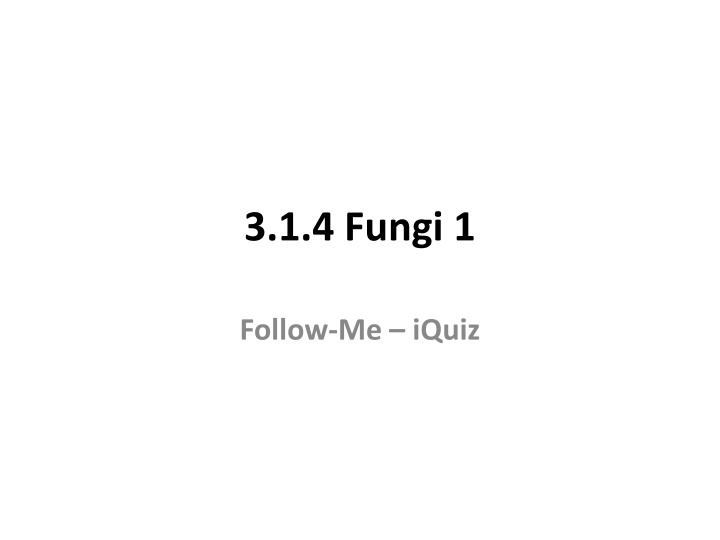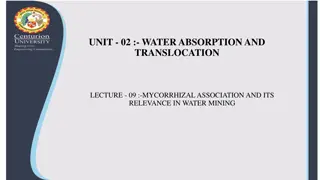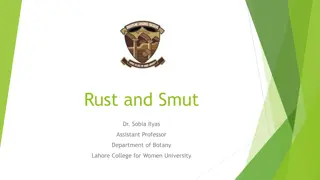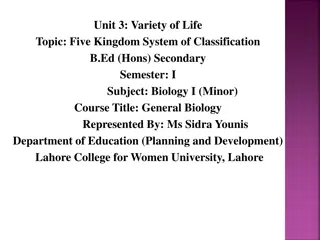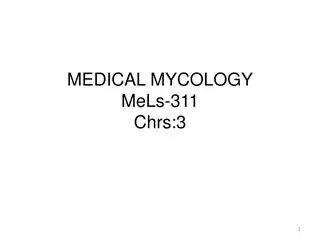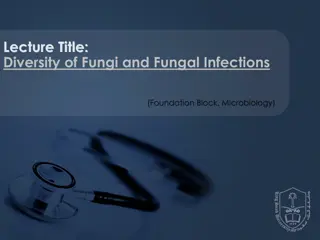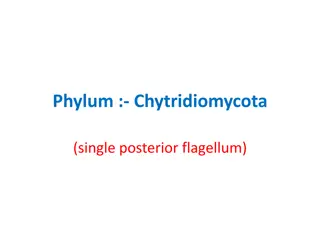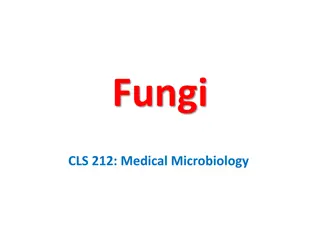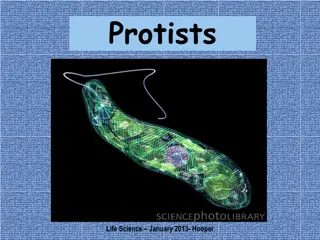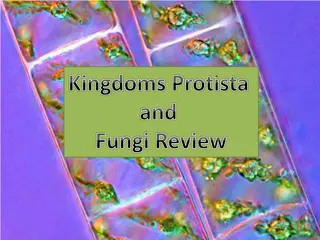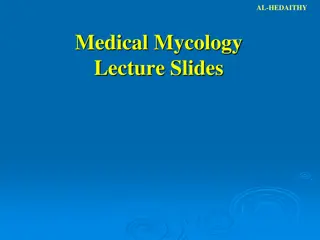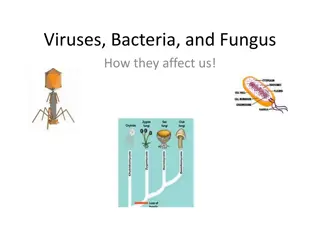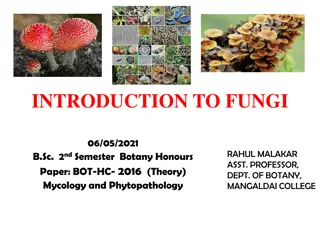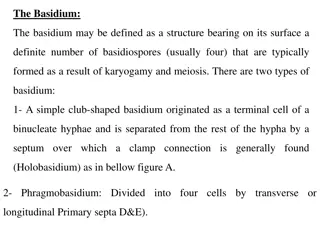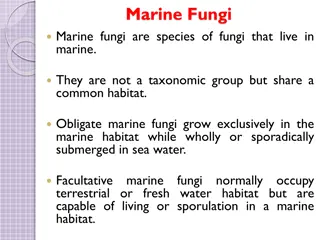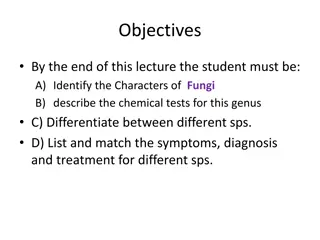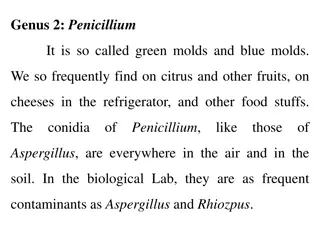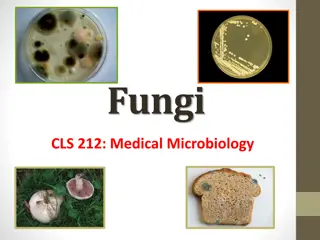Yeasts and Rhizopus in the Fungi Kingdom
Explore the characteristics of yeasts and Rhizopus within the Fungi kingdom through a series of quiz questions. Learn about their habitats, modes of reproduction, and unique features that distinguish them as fungi. Test your knowledge and delve into the fascinating world of these microorganisms.
Download Presentation

Please find below an Image/Link to download the presentation.
The content on the website is provided AS IS for your information and personal use only. It may not be sold, licensed, or shared on other websites without obtaining consent from the author.If you encounter any issues during the download, it is possible that the publisher has removed the file from their server.
You are allowed to download the files provided on this website for personal or commercial use, subject to the condition that they are used lawfully. All files are the property of their respective owners.
The content on the website is provided AS IS for your information and personal use only. It may not be sold, licensed, or shared on other websites without obtaining consent from the author.
E N D
Presentation Transcript
3.1.4 Fungi 1 Follow-Me iQuiz
Q. To which kingdom do yeasts belong? Anchors; Digestion; Absorption Recycling of nutrients and decay Live in or on another living organism causing harm Live in or on another living organism causing harm Anchors; Digestion; Absorption Recycling of nutrients and decay Live on dead organisms or matter Ash Rhizopus Live on dead organisms or matter Ash Rhizopus Ringworm; Athlete s foot; Potato blight; Thrush; Dry rot; Death cap Baking; Brewing Malt agar Ringworm; Athlete s foot; Potato blight; Thrush; Dry rot; Death cap Baking; Brewing Malt agar Chloroplast Multicellular; Method of reproduction; Size; Structure Saprophytic Multicellular; Method of reproduction; Size; Structure Chloroplast Saprophytic Digestion; Absorption Mycelium Spores all develop from one parent; No gametes involved Spores all develop from one parent; No gametes involved Digestion; Absorption Mycelium Filament Possesses membrane-bound nucleus or organelles Stolon; Rhizoids; Mycelium; Hyphae; Sporangium; Spores Possesses membrane- bound nucleus or organelles Stolon; Rhizoids; Mycelium; Hyphae; Sporangium; Spores Filament Produces gametes; Sexual reproduction Fungi Survival; Dispersal Produces gametes; Sexual reproduction Fungi Survival; Dispersal Yeast for brewing or baking; Agaricus campestris; Agaricus bisporus Yeast for brewing or baking; Agaricus campestris; Agaricus bisporus Keep populations under control; Natural selection Produces spores; Stores spores; Asexual reproduction Keep populations under control; Natural selection Produces spores; Stores spores; Asexual reproduction
CONGRATULATIONS Please CLICK on THIS BOX for the Next Question Please CLICK on THIS BOX for the Next Question
Q. State one feature of Rhizopus that indicates that Rhizopus belongs to the kingdom Fungi. Anchors; Digestion; Absorption Recycling of nutrients and decay Live in or on another living organism causing harm Live in or on another living organism causing harm Anchors; Digestion; Absorption Recycling of nutrients and decay Live on dead organisms or matter Ash Rhizopus Live on dead organisms or matter Ash Rhizopus Ringworm; Athlete s foot; Potato blight; Thrush; Dry rot; Death cap Baking; Brewing Malt agar Ringworm; Athlete s foot; Potato blight; Thrush; Dry rot; Death cap Baking; Brewing Malt agar Chloroplast Multicellular; Method of reproduction; Size; Structure Saprophytic Multicellular; Method of reproduction; Size; Structure Chloroplast Saprophytic Digestion; Absorption Mycelium Spores all develop from one parent; No gametes involved Spores all develop from one parent; No gametes involved Digestion; Absorption Mycelium Filament Possesses membrane-bound nucleus or organelles Stolon; Rhizoids; Mycelium; Hyphae; Sporangium; Spores Possesses membrane- bound nucleus or organelles Stolon; Rhizoids; Mycelium; Hyphae; Sporangium; Spores Filament Produces gametes; Sexual reproduction Fungi Survival; Dispersal Produces gametes; Sexual reproduction Fungi Survival; Dispersal Yeast for brewing or baking; Agaricus campestris; Agaricus bisporus Yeast for brewing or baking; Agaricus campestris; Agaricus bisporus Keep populations under control; Natural selection Produces spores; Stores spores; Asexual reproduction Keep populations under control; Natural selection Produces spores; Stores spores; Asexual reproduction
CONGRATULATIONS Please CLICK on THIS BOX for the Next Question Please CLICK on THIS BOX for the Next Question
Q. Yeasts are eukaryotic organisms. What does this mean? Anchors; Digestion; Absorption Recycling of nutrients and decay Live in or on another living organism causing harm Live in or on another living organism causing harm Anchors; Digestion; Absorption Recycling of nutrients and decay Live on dead organisms or matter Ash Rhizopus Live on dead organisms or matter Ash Rhizopus Ringworm; Athlete s foot; Potato blight; Thrush; Dry rot; Death cap Baking; Brewing Malt agar Ringworm; Athlete s foot; Potato blight; Thrush; Dry rot; Death cap Baking; Brewing Malt agar Chloroplast Multicellular; Method of reproduction; Size; Structure Saprophytic Multicellular; Method of reproduction; Size; Structure Chloroplast Saprophytic Digestion; Absorption Mycelium Spores all develop from one parent; No gametes involved Spores all develop from one parent; No gametes involved Digestion; Absorption Mycelium Filament Possesses membrane-bound nucleus or organelles Stolon; Rhizoids; Mycelium; Hyphae; Sporangium; Spores Possesses membrane- bound nucleus or organelles Stolon; Rhizoids; Mycelium; Hyphae; Sporangium; Spores Filament Produces gametes; Sexual reproduction Fungi Survival; Dispersal Produces gametes; Sexual reproduction Fungi Survival; Dispersal Yeast for brewing or baking; Agaricus campestris; Agaricus bisporus Yeast for brewing or baking; Agaricus campestris; Agaricus bisporus Keep populations under control; Natural selection Produces spores; Stores spores; Asexual reproduction Keep populations under control; Natural selection Produces spores; Stores spores; Asexual reproduction
CONGRATULATIONS Please CLICK on THIS BOX for the Next Question Please CLICK on THIS BOX for the Next Question
Q. Name the nutrient medium on which you grew leaf yeast Anchors; Digestion; Absorption Recycling of nutrients and decay Live in or on another living organism causing harm Live in or on another living organism causing harm Anchors; Digestion; Absorption Recycling of nutrients and decay Live on dead organisms or matter Ash Rhizopus Live on dead organisms or matter Ash Rhizopus Ringworm; Athlete s foot; Potato blight; Thrush; Dry rot; Death cap Baking; Brewing Malt agar Ringworm; Athlete s foot; Potato blight; Thrush; Dry rot; Death cap Baking; Brewing Malt agar Chloroplast Multicellular; Method of reproduction; Size; Structure Saprophytic Multicellular; Method of reproduction; Size; Structure Chloroplast Saprophytic Digestion; Absorption Mycelium Spores all develop from one parent; No gametes involved Spores all develop from one parent; No gametes involved Digestion; Absorption Mycelium Filament Possesses membrane-bound nucleus or organelles Stolon; Rhizoids; Mycelium; Hyphae; Sporangium; Spores Possesses membrane- bound nucleus or organelles Stolon; Rhizoids; Mycelium; Hyphae; Sporangium; Spores Filament Produces gametes; Sexual reproduction Fungi Survival; Dispersal Produces gametes; Sexual reproduction Fungi Survival; Dispersal Yeast for brewing or baking; Agaricus campestris; Agaricus bisporus Yeast for brewing or baking; Agaricus campestris; Agaricus bisporus Keep populations under control; Natural selection Produces spores; Stores spores; Asexual reproduction Keep populations under control; Natural selection Produces spores; Stores spores; Asexual reproduction
CONGRATULATIONS Please CLICK on THIS BOX for the Next Question Please CLICK on THIS BOX for the Next Question
Q. What are saprophytic fungi? Anchors; Digestion; Absorption Recycling of nutrients and decay Live in or on another living organism causing harm Live in or on another living organism causing harm Anchors; Digestion; Absorption Recycling of nutrients and decay Live on dead organisms or matter Ash Rhizopus Live on dead organisms or matter Ash Rhizopus Ringworm; Athlete s foot; Potato blight; Thrush; Dry rot; Death cap Baking; Brewing Malt agar Ringworm; Athlete s foot; Potato blight; Thrush; Dry rot; Death cap Baking; Brewing Malt agar Chloroplast Multicellular; Method of reproduction; Size; Structure Saprophytic Multicellular; Method of reproduction; Size; Structure Chloroplast Saprophytic Digestion; Absorption Mycelium Spores all develop from one parent; No gametes involved Spores all develop from one parent; No gametes involved Digestion; Absorption Mycelium Filament Possesses membrane-bound nucleus or organelles Stolon; Rhizoids; Mycelium; Hyphae; Sporangium; Spores Possesses membrane- bound nucleus or organelles Stolon; Rhizoids; Mycelium; Hyphae; Sporangium; Spores Filament Produces gametes; Sexual reproduction Fungi Survival; Dispersal Produces gametes; Sexual reproduction Fungi Survival; Dispersal Yeast for brewing or baking; Agaricus campestris; Agaricus bisporus Yeast for brewing or baking; Agaricus campestris; Agaricus bisporus Keep populations under control; Natural selection Produces spores; Stores spores; Asexual reproduction Keep populations under control; Natural selection Produces spores; Stores spores; Asexual reproduction
CONGRATULATIONS Please CLICK on THIS BOX for the Next Question Please CLICK on THIS BOX for the Next Question
Q. Give one example of a beneficial fungus. Anchors; Digestion; Absorption Recycling of nutrients and decay Live in or on another living organism causing harm Live in or on another living organism causing harm Anchors; Digestion; Absorption Recycling of nutrients and decay Live on dead organisms or matter Ash Rhizopus Live on dead organisms or matter Ash Rhizopus Ringworm; Athlete s foot; Potato blight; Thrush; Dry rot; Death cap Baking; Brewing Malt agar Ringworm; Athlete s foot; Potato blight; Thrush; Dry rot; Death cap Baking; Brewing Malt agar Chloroplast Multicellular; Method of reproduction; Size; Structure Saprophytic Multicellular; Method of reproduction; Size; Structure Chloroplast Saprophytic Digestion; Absorption Mycelium Spores all develop from one parent; No gametes involved Spores all develop from one parent; No gametes involved Digestion; Absorption Mycelium Filament Possesses membrane-bound nucleus or organelles Stolon; Rhizoids; Mycelium; Hyphae; Sporangium; Spores Possesses membrane- bound nucleus or organelles Stolon; Rhizoids; Mycelium; Hyphae; Sporangium; Spores Filament Produces gametes; Sexual reproduction Fungi Survival; Dispersal Produces gametes; Sexual reproduction Fungi Survival; Dispersal Yeast for brewing or baking; Agaricus campestris; Agaricus bisporus Yeast for brewing or baking; Agaricus campestris; Agaricus bisporus Keep populations under control; Natural selection Produces spores; Stores spores; Asexual reproduction Keep populations under control; Natural selection Produces spores; Stores spores; Asexual reproduction
CONGRATULATIONS Please CLICK on THIS BOX for the Next Question Please CLICK on THIS BOX for the Next Question
Q. State a function of the rhizoid in fungi. Anchors; Digestion; Absorption Recycling of nutrients and decay Live in or on another living organism causing harm Live in or on another living organism causing harm Anchors; Digestion; Absorption Recycling of nutrients and decay Live on dead organisms or matter Ash Rhizopus Live on dead organisms or matter Ash Rhizopus Ringworm; Athlete s foot; Potato blight; Thrush; Dry rot; Death cap Baking; Brewing Malt agar Ringworm; Athlete s foot; Potato blight; Thrush; Dry rot; Death cap Baking; Brewing Malt agar Chloroplast Multicellular; Method of reproduction; Size; Structure Saprophytic Multicellular; Method of reproduction; Size; Structure Chloroplast Saprophytic Digestion; Absorption Mycelium Spores all develop from one parent; No gametes involved Spores all develop from one parent; No gametes involved Digestion; Absorption Mycelium Filament Possesses membrane-bound nucleus or organelles Stolon; Rhizoids; Mycelium; Hyphae; Sporangium; Spores Possesses membrane- bound nucleus or organelles Stolon; Rhizoids; Mycelium; Hyphae; Sporangium; Spores Filament Produces gametes; Sexual reproduction Fungi Survival; Dispersal Produces gametes; Sexual reproduction Fungi Survival; Dispersal Yeast for brewing or baking; Agaricus campestris; Agaricus bisporus Yeast for brewing or baking; Agaricus campestris; Agaricus bisporus Keep populations under control; Natural selection Produces spores; Stores spores; Asexual reproduction Keep populations under control; Natural selection Produces spores; Stores spores; Asexual reproduction
CONGRATULATIONS Please CLICK on THIS BOX for the Next Question Please CLICK on THIS BOX for the Next Question
Q. What is a hypha? Anchors; Digestion; Absorption Recycling of nutrients and decay Live in or on another living organism causing harm Live in or on another living organism causing harm Anchors; Digestion; Absorption Recycling of nutrients and decay Live on dead organisms or matter Ash Rhizopus Live on dead organisms or matter Ash Rhizopus Ringworm; Athlete s foot; Potato blight; Thrush; Dry rot; Death cap Baking; Brewing Malt agar Ringworm; Athlete s foot; Potato blight; Thrush; Dry rot; Death cap Baking; Brewing Malt agar Chloroplast Multicellular; Method of reproduction; Size; Structure Saprophytic Multicellular; Method of reproduction; Size; Structure Chloroplast Saprophytic Digestion; Absorption Mycelium Spores all develop from one parent; No gametes involved Spores all develop from one parent; No gametes involved Digestion; Absorption Mycelium Filament Possesses membrane-bound nucleus or organelles Stolon; Rhizoids; Mycelium; Hyphae; Sporangium; Spores Possesses membrane- bound nucleus or organelles Stolon; Rhizoids; Mycelium; Hyphae; Sporangium; Spores Filament Produces gametes; Sexual reproduction Fungi Survival; Dispersal Produces gametes; Sexual reproduction Fungi Survival; Dispersal Yeast for brewing or baking; Agaricus campestris; Agaricus bisporus Yeast for brewing or baking; Agaricus campestris; Agaricus bisporus Keep populations under control; Natural selection Produces spores; Stores spores; Asexual reproduction Keep populations under control; Natural selection Produces spores; Stores spores; Asexual reproduction
CONGRATULATIONS Please CLICK on THIS BOX for the Next Question Please CLICK on THIS BOX for the Next Question
Q. What is the role of saprophytic fungi in nature? Anchors; Digestion; Absorption Recycling of nutrients and decay Live in or on another living organism causing harm Live in or on another living organism causing harm Anchors; Digestion; Absorption Recycling of nutrients and decay Live on dead organisms or matter Ash Rhizopus Live on dead organisms or matter Ash Rhizopus Ringworm; Athlete s foot; Potato blight; Thrush; Dry rot; Death cap Baking; Brewing Malt agar Ringworm; Athlete s foot; Potato blight; Thrush; Dry rot; Death cap Baking; Brewing Malt agar Chloroplast Multicellular; Method of reproduction; Size; Structure Saprophytic Multicellular; Method of reproduction; Size; Structure Chloroplast Saprophytic Digestion; Absorption Mycelium Spores all develop from one parent; No gametes involved Spores all develop from one parent; No gametes involved Digestion; Absorption Mycelium Filament Possesses membrane-bound nucleus or organelles Stolon; Rhizoids; Mycelium; Hyphae; Sporangium; Spores Possesses membrane- bound nucleus or organelles Stolon; Rhizoids; Mycelium; Hyphae; Sporangium; Spores Filament Produces gametes; Sexual reproduction Fungi Survival; Dispersal Produces gametes; Sexual reproduction Fungi Survival; Dispersal Yeast for brewing or baking; Agaricus campestris; Agaricus bisporus Yeast for brewing or baking; Agaricus campestris; Agaricus bisporus Keep populations under control; Natural selection Produces spores; Stores spores; Asexual reproduction Keep populations under control; Natural selection Produces spores; Stores spores; Asexual reproduction
CONGRATULATIONS Please CLICK on THIS BOX for the Next Question Please CLICK on THIS BOX for the Next Question
Q. A mass of hyphae is called a Anchors; Digestion; Absorption Recycling of nutrients and decay Live in or on another living organism causing harm Live in or on another living organism causing harm Anchors; Digestion; Absorption Recycling of nutrients and decay Live on dead organisms or matter Ash Rhizopus Live on dead organisms or matter Ash Rhizopus Ringworm; Athlete s foot; Potato blight; Thrush; Dry rot; Death cap Baking; Brewing Malt agar Ringworm; Athlete s foot; Potato blight; Thrush; Dry rot; Death cap Baking; Brewing Malt agar Chloroplast Multicellular; Method of reproduction; Size; Structure Saprophytic Multicellular; Method of reproduction; Size; Structure Chloroplast Saprophytic Digestion; Absorption Mycelium Spores all develop from one parent; No gametes involved Spores all develop from one parent; No gametes involved Digestion; Absorption Mycelium Filament Possesses membrane-bound nucleus or organelles Stolon; Rhizoids; Mycelium; Hyphae; Sporangium; Spores Possesses membrane- bound nucleus or organelles Stolon; Rhizoids; Mycelium; Hyphae; Sporangium; Spores Filament Produces gametes; Sexual reproduction Fungi Survival; Dispersal Produces gametes; Sexual reproduction Fungi Survival; Dispersal Yeast for brewing or baking; Agaricus campestris; Agaricus bisporus Yeast for brewing or baking; Agaricus campestris; Agaricus bisporus Keep populations under control; Natural selection Produces spores; Stores spores; Asexual reproduction Keep populations under control; Natural selection Produces spores; Stores spores; Asexual reproduction
CONGRATULATIONS Please CLICK on THIS BOX for the Next Question Please CLICK on THIS BOX for the Next Question
Q. State a function of the sporangium in fungi. Anchors; Digestion; Absorption Recycling of nutrients and decay Live in or on another living organism causing harm Live in or on another living organism causing harm Anchors; Digestion; Absorption Recycling of nutrients and decay Live on dead organisms or matter Ash Rhizopus Live on dead organisms or matter Ash Rhizopus Ringworm; Athlete s foot; Potato blight; Thrush; Dry rot; Death cap Baking; Brewing Malt agar Ringworm; Athlete s foot; Potato blight; Thrush; Dry rot; Death cap Baking; Brewing Malt agar Chloroplast Multicellular; Method of reproduction; Size; Structure Saprophytic Multicellular; Method of reproduction; Size; Structure Chloroplast Saprophytic Digestion; Absorption Mycelium Spores all develop from one parent; No gametes involved Spores all develop from one parent; No gametes involved Digestion; Absorption Mycelium Filament Possesses membrane-bound nucleus or organelles Stolon; Rhizoids; Mycelium; Hyphae; Sporangium; Spores Possesses membrane- bound nucleus or organelles Stolon; Rhizoids; Mycelium; Hyphae; Sporangium; Spores Filament Produces gametes; Sexual reproduction Fungi Survival; Dispersal Produces gametes; Sexual reproduction Fungi Survival; Dispersal Yeast for brewing or baking; Agaricus campestris; Agaricus bisporus Yeast for brewing or baking; Agaricus campestris; Agaricus bisporus Keep populations under control; Natural selection Produces spores; Stores spores; Asexual reproduction Keep populations under control; Natural selection Produces spores; Stores spores; Asexual reproduction
CONGRATULATIONS Please CLICK on THIS BOX for the Next Question Please CLICK on THIS BOX for the Next Question
Q. Name a fungus, other than yeast, that you studied. Anchors; Digestion; Absorption Recycling of nutrients and decay Live in or on another living organism causing harm Live in or on another living organism causing harm Anchors; Digestion; Absorption Recycling of nutrients and decay Live on dead organisms or matter Ash Rhizopus Live on dead organisms or matter Ash Rhizopus Ringworm; Athlete s foot; Potato blight; Thrush; Dry rot; Death cap Baking; Brewing Malt agar Ringworm; Athlete s foot; Potato blight; Thrush; Dry rot; Death cap Baking; Brewing Malt agar Chloroplast Multicellular; Method of reproduction; Size; Structure Saprophytic Multicellular; Method of reproduction; Size; Structure Chloroplast Saprophytic Digestion; Absorption Mycelium Spores all develop from one parent; No gametes involved Spores all develop from one parent; No gametes involved Digestion; Absorption Mycelium Filament Possesses membrane-bound nucleus or organelles Stolon; Rhizoids; Mycelium; Hyphae; Sporangium; Spores Possesses membrane- bound nucleus or organelles Stolon; Rhizoids; Mycelium; Hyphae; Sporangium; Spores Filament Produces gametes; Sexual reproduction Fungi Survival; Dispersal Produces gametes; Sexual reproduction Fungi Survival; Dispersal Yeast for brewing or baking; Agaricus campestris; Agaricus bisporus Yeast for brewing or baking; Agaricus campestris; Agaricus bisporus Keep populations under control; Natural selection Produces spores; Stores spores; Asexual reproduction Keep populations under control; Natural selection Produces spores; Stores spores; Asexual reproduction
CONGRATULATIONS Please CLICK on THIS BOX for the Next Question Please CLICK on THIS BOX for the Next Question
Q. State one way in which yeast is beneficial to humans. Anchors; Digestion; Absorption Recycling of nutrients and decay Live in or on another living organism causing harm Live in or on another living organism causing harm Anchors; Digestion; Absorption Recycling of nutrients and decay Live on dead organisms or matter Ash Rhizopus Live on dead organisms or matter Ash Rhizopus Ringworm; Athlete s foot; Potato blight; Thrush; Dry rot; Death cap Baking; Brewing Malt agar Ringworm; Athlete s foot; Potato blight; Thrush; Dry rot; Death cap Baking; Brewing Malt agar Chloroplast Multicellular; Method of reproduction; Size; Structure Saprophytic Multicellular; Method of reproduction; Size; Structure Chloroplast Saprophytic Digestion; Absorption Mycelium Spores all develop from one parent; No gametes involved Spores all develop from one parent; No gametes involved Digestion; Absorption Mycelium Filament Possesses membrane-bound nucleus or organelles Stolon; Rhizoids; Mycelium; Hyphae; Sporangium; Spores Possesses membrane- bound nucleus or organelles Stolon; Rhizoids; Mycelium; Hyphae; Sporangium; Spores Filament Produces gametes; Sexual reproduction Fungi Survival; Dispersal Produces gametes; Sexual reproduction Fungi Survival; Dispersal Yeast for brewing or baking; Agaricus campestris; Agaricus bisporus Yeast for brewing or baking; Agaricus campestris; Agaricus bisporus Keep populations under control; Natural selection Produces spores; Stores spores; Asexual reproduction Keep populations under control; Natural selection Produces spores; Stores spores; Asexual reproduction
CONGRATULATIONS Please CLICK on THIS BOX for the Next Question Please CLICK on THIS BOX for the Next Question
Q. From what plant did you obtain the leaf yeast Anchors; Digestion; Absorption Recycling of nutrients and decay Live in or on another living organism causing harm Live in or on another living organism causing harm Anchors; Digestion; Absorption Recycling of nutrients and decay Live on dead organisms or matter Ash Rhizopus Live on dead organisms or matter Ash Rhizopus Ringworm; Athlete s foot; Potato blight; Thrush; Dry rot; Death cap Baking; Brewing Malt agar Ringworm; Athlete s foot; Potato blight; Thrush; Dry rot; Death cap Baking; Brewing Malt agar Chloroplast Multicellular; Method of reproduction; Size; Structure Saprophytic Multicellular; Method of reproduction; Size; Structure Chloroplast Saprophytic Digestion; Absorption Mycelium Spores all develop from one parent; No gametes involved Spores all develop from one parent; No gametes involved Digestion; Absorption Mycelium Filament Possesses membrane-bound nucleus or organelles Stolon; Rhizoids; Mycelium; Hyphae; Sporangium; Spores Possesses membrane- bound nucleus or organelles Stolon; Rhizoids; Mycelium; Hyphae; Sporangium; Spores Filament Produces gametes; Sexual reproduction Fungi Survival; Dispersal Produces gametes; Sexual reproduction Fungi Survival; Dispersal Yeast for brewing or baking; Agaricus campestris; Agaricus bisporus Yeast for brewing or baking; Agaricus campestris; Agaricus bisporus Keep populations under control; Natural selection Produces spores; Stores spores; Asexual reproduction Keep populations under control; Natural selection Produces spores; Stores spores; Asexual reproduction
CONGRATULATIONS Please CLICK on THIS BOX for the Next Question Please CLICK on THIS BOX for the Next Question
Q. What are parasitic fungi? Anchors; Digestion; Absorption Recycling of nutrients and decay Live in or on another living organism causing harm Live in or on another living organism causing harm Anchors; Digestion; Absorption Recycling of nutrients and decay Live on dead organisms or matter Ash Rhizopus Live on dead organisms or matter Ash Rhizopus Ringworm; Athlete s foot; Potato blight; Thrush; Dry rot; Death cap Baking; Brewing Malt agar Ringworm; Athlete s foot; Potato blight; Thrush; Dry rot; Death cap Baking; Brewing Malt agar Chloroplast Multicellular; Method of reproduction; Size; Structure Saprophytic Multicellular; Method of reproduction; Size; Structure Chloroplast Saprophytic Digestion; Absorption Mycelium Spores all develop from one parent; No gametes involved Spores all develop from one parent; No gametes involved Digestion; Absorption Mycelium Filament Possesses membrane-bound nucleus or organelles Stolon; Rhizoids; Mycelium; Hyphae; Sporangium; Spores Possesses membrane- bound nucleus or organelles Stolon; Rhizoids; Mycelium; Hyphae; Sporangium; Spores Filament Produces gametes; Sexual reproduction Fungi Survival; Dispersal Produces gametes; Sexual reproduction Fungi Survival; Dispersal Yeast for brewing or baking; Agaricus campestris; Agaricus bisporus Yeast for brewing or baking; Agaricus campestris; Agaricus bisporus Keep populations under control; Natural selection Produces spores; Stores spores; Asexual reproduction Keep populations under control; Natural selection Produces spores; Stores spores; Asexual reproduction
CONGRATULATIONS Please CLICK on THIS BOX for the Next Question Please CLICK on THIS BOX for the Next Question
Q. State a function of the zygospore in fungi. Anchors; Digestion; Absorption Recycling of nutrients and decay Live in or on another living organism causing harm Live in or on another living organism causing harm Anchors; Digestion; Absorption Recycling of nutrients and decay Live on dead organisms or matter Ash Rhizopus Live on dead organisms or matter Ash Rhizopus Ringworm; Athlete s foot; Potato blight; Thrush; Dry rot; Death cap Baking; Brewing Malt agar Ringworm; Athlete s foot; Potato blight; Thrush; Dry rot; Death cap Baking; Brewing Malt agar Chloroplast Multicellular; Method of reproduction; Size; Structure Saprophytic Multicellular; Method of reproduction; Size; Structure Chloroplast Saprophytic Digestion; Absorption Mycelium Spores all develop from one parent; No gametes involved Spores all develop from one parent; No gametes involved Digestion; Absorption Mycelium Filament Possesses membrane-bound nucleus or organelles Stolon; Rhizoids; Mycelium; Hyphae; Sporangium; Spores Possesses membrane- bound nucleus or organelles Stolon; Rhizoids; Mycelium; Hyphae; Sporangium; Spores Filament Produces gametes; Sexual reproduction Fungi Survival; Dispersal Produces gametes; Sexual reproduction Fungi Survival; Dispersal Yeast for brewing or baking; Agaricus campestris; Agaricus bisporus Yeast for brewing or baking; Agaricus campestris; Agaricus bisporus Keep populations under control; Natural selection Produces spores; Stores spores; Asexual reproduction Keep populations under control; Natural selection Produces spores; Stores spores; Asexual reproduction
CONGRATULATIONS Please CLICK on THIS BOX for the Next Question Please CLICK on THIS BOX for the Next Question
Q. Give one way in which Rhizopus differs from yeast. Anchors; Digestion; Absorption Recycling of nutrients and decay Live in or on another living organism causing harm Live in or on another living organism causing harm Anchors; Digestion; Absorption Recycling of nutrients and decay Live on dead organisms or matter Ash Rhizopus Live on dead organisms or matter Ash Rhizopus Ringworm; Athlete s foot; Potato blight; Thrush; Dry rot; Death cap Baking; Brewing Malt agar Ringworm; Athlete s foot; Potato blight; Thrush; Dry rot; Death cap Baking; Brewing Malt agar Chloroplast Multicellular; Method of reproduction; Size; Structure Saprophytic Multicellular; Method of reproduction; Size; Structure Chloroplast Saprophytic Digestion; Absorption Mycelium Spores all develop from one parent; No gametes involved Spores all develop from one parent; No gametes involved Digestion; Absorption Mycelium Filament Possesses membrane-bound nucleus or organelles Stolon; Rhizoids; Mycelium; Hyphae; Sporangium; Spores Possesses membrane- bound nucleus or organelles Stolon; Rhizoids; Mycelium; Hyphae; Sporangium; Spores Filament Produces gametes; Sexual reproduction Fungi Survival; Dispersal Produces gametes; Sexual reproduction Fungi Survival; Dispersal Yeast for brewing or baking; Agaricus campestris; Agaricus bisporus Yeast for brewing or baking; Agaricus campestris; Agaricus bisporus Keep populations under control; Natural selection Produces spores; Stores spores; Asexual reproduction Keep populations under control; Natural selection Produces spores; Stores spores; Asexual reproduction
CONGRATULATIONS Please CLICK on THIS BOX for the Next Question Please CLICK on THIS BOX for the Next Question
Q. Give two examples of a harmful fungus. Anchors; Digestion; Absorption Recycling of nutrients and decay Live in or on another living organism causing harm Live in or on another living organism causing harm Anchors; Digestion; Absorption Recycling of nutrients and decay Live on dead organisms or matter Ash Rhizopus Live on dead organisms or matter Ash Rhizopus Ringworm; Athlete s foot; Potato blight; Thrush; Dry rot; Death cap Baking; Brewing Malt agar Ringworm; Athlete s foot; Potato blight; Thrush; Dry rot; Death cap Baking; Brewing Malt agar Chloroplast Multicellular; Method of reproduction; Size; Structure Saprophytic Multicellular; Method of reproduction; Size; Structure Chloroplast Saprophytic Digestion; Absorption Mycelium Spores all develop from one parent; No gametes involved Spores all develop from one parent; No gametes involved Digestion; Absorption Mycelium Filament Possesses membrane-bound nucleus or organelles Stolon; Rhizoids; Mycelium; Hyphae; Sporangium; Spores Possesses membrane- bound nucleus or organelles Stolon; Rhizoids; Mycelium; Hyphae; Sporangium; Spores Filament Produces gametes; Sexual reproduction Fungi Survival; Dispersal Produces gametes; Sexual reproduction Fungi Survival; Dispersal Yeast for brewing or baking; Agaricus campestris; Agaricus bisporus Yeast for brewing or baking; Agaricus campestris; Agaricus bisporus Keep populations under control; Natural selection Produces spores; Stores spores; Asexual reproduction Keep populations under control; Natural selection Produces spores; Stores spores; Asexual reproduction
CONGRATULATIONS Please CLICK on THIS BOX for the Next Question Please CLICK on THIS BOX for the Next Question
Q. Give a role, other than anchorage, for rhizoids. Anchors; Digestion; Absorption Recycling of nutrients and decay Live in or on another living organism causing harm Live in or on another living organism causing harm Anchors; Digestion; Absorption Recycling of nutrients and decay Live on dead organisms or matter Ash Rhizopus Live on dead organisms or matter Ash Rhizopus Ringworm; Athlete s foot; Potato blight; Thrush; Dry rot; Death cap Baking; Brewing Malt agar Ringworm; Athlete s foot; Potato blight; Thrush; Dry rot; Death cap Baking; Brewing Malt agar Chloroplast Multicellular; Method of reproduction; Size; Structure Saprophytic Multicellular; Method of reproduction; Size; Structure Chloroplast Saprophytic Digestion; Absorption Mycelium Spores all develop from one parent; No gametes involved Spores all develop from one parent; No gametes involved Digestion; Absorption Mycelium Filament Possesses membrane-bound nucleus or organelles Stolon; Rhizoids; Mycelium; Hyphae; Sporangium; Spores Possesses membrane- bound nucleus or organelles Stolon; Rhizoids; Mycelium; Hyphae; Sporangium; Spores Filament Produces gametes; Sexual reproduction Fungi Survival; Dispersal Produces gametes; Sexual reproduction Fungi Survival; Dispersal Yeast for brewing or baking; Agaricus campestris; Agaricus bisporus Yeast for brewing or baking; Agaricus campestris; Agaricus bisporus Keep populations under control; Natural selection Produces spores; Stores spores; Asexual reproduction Keep populations under control; Natural selection Produces spores; Stores spores; Asexual reproduction
CONGRATULATIONS Please CLICK on THIS BOX for the Next Question Please CLICK on THIS BOX for the Next Question
Q. Which term describes the mode of nutrition of Rhizopus? Anchors; Digestion; Absorption Recycling of nutrients and decay Live in or on another living organism causing harm Live in or on another living organism causing harm Anchors; Digestion; Absorption Recycling of nutrients and decay Live on dead organisms or matter Ash Rhizopus Live on dead organisms or matter Ash Rhizopus Ringworm; Athlete s foot; Potato blight; Thrush; Dry rot; Death cap Baking; Brewing Malt agar Ringworm; Athlete s foot; Potato blight; Thrush; Dry rot; Death cap Baking; Brewing Malt agar Chloroplast Multicellular; Method of reproduction; Size; Structure Saprophytic Multicellular; Method of reproduction; Size; Structure Chloroplast Saprophytic Digestion; Absorption Mycelium Spores all develop from one parent; No gametes involved Spores all develop from one parent; No gametes involved Digestion; Absorption Mycelium Filament Possesses membrane-bound nucleus or organelles Stolon; Rhizoids; Mycelium; Hyphae; Sporangium; Spores Possesses membrane- bound nucleus or organelles Stolon; Rhizoids; Mycelium; Hyphae; Sporangium; Spores Filament Produces gametes; Sexual reproduction Fungi Survival; Dispersal Produces gametes; Sexual reproduction Fungi Survival; Dispersal Yeast for brewing or baking; Agaricus campestris; Agaricus bisporus Yeast for brewing or baking; Agaricus campestris; Agaricus bisporus Keep populations under control; Natural selection Produces spores; Stores spores; Asexual reproduction Keep populations under control; Natural selection Produces spores; Stores spores; Asexual reproduction
CONGRATULATIONS Please CLICK on THIS BOX for the Next Question Please CLICK on THIS BOX for the Next Question
Q. What is the role of parasitic fungi in nature? Anchors; Digestion; Absorption Recycling of nutrients and decay Live in or on another living organism causing harm Live in or on another living organism causing harm Anchors; Digestion; Absorption Recycling of nutrients and decay Live on dead organisms or matter Ash Rhizopus Live on dead organisms or matter Ash Rhizopus Ringworm; Athlete s foot; Potato blight; Thrush; Dry rot; Death cap Baking; Brewing Malt agar Ringworm; Athlete s foot; Potato blight; Thrush; Dry rot; Death cap Baking; Brewing Malt agar Chloroplast Multicellular; Method of reproduction; Size; Structure Saprophytic Multicellular; Method of reproduction; Size; Structure Chloroplast Saprophytic Digestion; Absorption Mycelium Spores all develop from one parent; No gametes involved Spores all develop from one parent; No gametes involved Digestion; Absorption Mycelium Filament Possesses membrane-bound nucleus or organelles Stolon; Rhizoids; Mycelium; Hyphae; Sporangium; Spores Possesses membrane- bound nucleus or organelles Stolon; Rhizoids; Mycelium; Hyphae; Sporangium; Spores Filament Produces gametes; Sexual reproduction Fungi Survival; Dispersal Produces gametes; Sexual reproduction Fungi Survival; Dispersal Yeast for brewing or baking; Agaricus campestris; Agaricus bisporus Yeast for brewing or baking; Agaricus campestris; Agaricus bisporus Keep populations under control; Natural selection Produces spores; Stores spores; Asexual reproduction Keep populations under control; Natural selection Produces spores; Stores spores; Asexual reproduction
CONGRATULATIONS Please CLICK on THIS BOX for the Next Question Please CLICK on THIS BOX for the Next Question
Q. Why is the reproduction associated with the sporangium of Rhizopus asexual? Anchors; Digestion; Absorption Recycling of nutrients and decay Live in or on another living organism causing harm Live in or on another living organism causing harm Anchors; Digestion; Absorption Recycling of nutrients and decay Live on dead organisms or matter Ash Rhizopus Live on dead organisms or matter Ash Rhizopus Ringworm; Athlete s foot; Potato blight; Thrush; Dry rot; Death cap Baking; Brewing Malt agar Ringworm; Athlete s foot; Potato blight; Thrush; Dry rot; Death cap Baking; Brewing Malt agar Chloroplast Multicellular; Method of reproduction; Size; Structure Saprophytic Multicellular; Method of reproduction; Size; Structure Chloroplast Saprophytic Digestion; Absorption Mycelium Spores all develop from one parent; No gametes involved Spores all develop from one parent; No gametes involved Digestion; Absorption Mycelium Filament Possesses membrane-bound nucleus or organelles Stolon; Rhizoids; Mycelium; Hyphae; Sporangium; Spores Possesses membrane- bound nucleus or organelles Stolon; Rhizoids; Mycelium; Hyphae; Sporangium; Spores Filament Produces gametes; Sexual reproduction Fungi Survival; Dispersal Produces gametes; Sexual reproduction Fungi Survival; Dispersal Yeast for brewing or baking; Agaricus campestris; Agaricus bisporus Yeast for brewing or baking; Agaricus campestris; Agaricus bisporus Keep populations under control; Natural selection Produces spores; Stores spores; Asexual reproduction Keep populations under control; Natural selection Produces spores; Stores spores; Asexual reproduction
CONGRATULATIONS Please CLICK on THIS BOX for the Next Question Please CLICK on THIS BOX for the Next Question
Q. State a function of the gametangium in fungi. Anchors; Digestion; Absorption Recycling of nutrients and decay Live in or on another living organism causing harm Live in or on another living organism causing harm Anchors; Digestion; Absorption Recycling of nutrients and decay Live on dead organisms or matter Ash Rhizopus Live on dead organisms or matter Ash Rhizopus Ringworm; Athlete s foot; Potato blight; Thrush; Dry rot; Death cap Baking; Brewing Malt agar Ringworm; Athlete s foot; Potato blight; Thrush; Dry rot; Death cap Baking; Brewing Malt agar Chloroplast Multicellular; Method of reproduction; Size; Structure Saprophytic Multicellular; Method of reproduction; Size; Structure Chloroplast Saprophytic Digestion; Absorption Mycelium Spores all develop from one parent; No gametes involved Spores all develop from one parent; No gametes involved Digestion; Absorption Mycelium Filament Possesses membrane-bound nucleus or organelles Stolon; Rhizoids; Mycelium; Hyphae; Sporangium; Spores Possesses membrane- bound nucleus or organelles Stolon; Rhizoids; Mycelium; Hyphae; Sporangium; Spores Filament Produces gametes; Sexual reproduction Fungi Survival; Dispersal Produces gametes; Sexual reproduction Fungi Survival; Dispersal Yeast for brewing or baking; Agaricus campestris; Agaricus bisporus Yeast for brewing or baking; Agaricus campestris; Agaricus bisporus Keep populations under control; Natural selection Produces spores; Stores spores; Asexual reproduction Keep populations under control; Natural selection Produces spores; Stores spores; Asexual reproduction
CONGRATULATIONS Please CLICK on THIS BOX for the Next Question Please CLICK on THIS BOX for the Next Question
Q. Name one structure in plant cells not found in fungi. Anchors; Digestion; Absorption Recycling of nutrients and decay Live in or on another living organism causing harm Live in or on another living organism causing harm Anchors; Digestion; Absorption Recycling of nutrients and decay Live on dead organisms or matter Ash Rhizopus Live on dead organisms or matter Ash Rhizopus Ringworm; Athlete s foot; Potato blight; Thrush; Dry rot; Death cap Baking; Brewing Malt agar Ringworm; Athlete s foot; Potato blight; Thrush; Dry rot; Death cap Baking; Brewing Malt agar Chloroplast Multicellular; Method of reproduction; Size; Structure Saprophytic Multicellular; Method of reproduction; Size; Structure Chloroplast Saprophytic Digestion; Absorption Mycelium Spores all develop from one parent; No gametes involved Spores all develop from one parent; No gametes involved Digestion; Absorption Mycelium Filament Possesses membrane-bound nucleus or organelles Stolon; Rhizoids; Mycelium; Hyphae; Sporangium; Spores Possesses membrane- bound nucleus or organelles Stolon; Rhizoids; Mycelium; Hyphae; Sporangium; Spores Filament Produces gametes; Sexual reproduction Fungi Survival; Dispersal Produces gametes; Sexual reproduction Fungi Survival; Dispersal Yeast for brewing or baking; Agaricus campestris; Agaricus bisporus Yeast for brewing or baking; Agaricus campestris; Agaricus bisporus Keep populations under control; Natural selection Produces spores; Stores spores; Asexual reproduction Keep populations under control; Natural selection Produces spores; Stores spores; Asexual reproduction
CONGRATULATIONS You re Brilliant
Incorrect Please CLICK on THIS BOX to Try Again Please CLICK on THIS BOX to Try Again
